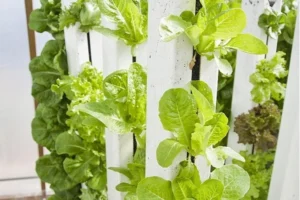Hydroponics is quickly becoming a go-to method for growing plants indoors, and it’s easy to see why. This soil-free gardening technique allows you to grow a variety of plants right in the comfort of your home, no matter the time of year. Whether you’re interested in herbs, leafy greens, or even small fruits, hydroponics provides a way to grow your own plants with minimal space and effort. As people continue to embrace this innovative gardening method, its popularity is growing, especially for those wanting to enjoy homegrown greens and herbs at their fingertips.
However, as with any new hobby, beginners can run into a few bumps along the way. The good news is that avoiding these pitfalls can set you up for success in your hydroponic journey. In this article, we’ll explore five common mistakes that newcomers often make and offer practical tips to help you steer clear of them. By learning from these missteps, you’ll be well on your way to growing healthy, thriving plants in no time.
Mistake #1: Overwatering or Underwatering Plants
One of the most common mistakes new hydroponic gardeners make is getting the watering right. Whether it’s too much water or not enough, both can have a big impact on plant health. In a hydroponic system, the right balance is crucial because the roots rely on a constant supply of water and nutrients to grow. Too little water and your plants can dry out, leading to weak growth or even death. On the other hand, too much water can cause root rot and other issues that disrupt the plant’s ability to absorb nutrients.
So, how do you tell if you’re overwatering or underwatering? With overwatering, you’ll often see yellowing leaves, wilting, or a soggy root system. Plants may also look droopy even though the system is flooded with water. Underwatering, on the other hand, can result in brown, crispy leaves and slow or stunted growth, as the roots simply aren’t getting enough hydration to support the plant.
To avoid these issues, it’s essential to monitor your system’s water levels regularly. Most hydroponic setups have water level indicators, but you can also check the moisture around the roots to gauge the water’s adequacy. Setting up a consistent watering schedule can make all the difference. You can start by using a timer for your pumps or manually topping off your system to ensure the water stays at optimal levels. Keeping an eye on the moisture in the medium and adjusting as needed will keep your plants healthy and thriving.
Mistake #2: Incorrect pH Levels
When it comes to hydroponic gardening, the pH level of your water is one of the most important factors for plant health. pH measures the acidity or alkalinity of the solution, and if it’s off, your plants won’t be able to absorb nutrients properly. Even if you’re using the best nutrients available, a poor pH balance can prevent them from being taken up by the roots, leading to nutrient deficiencies and poor growth.
Each plant has its own preferred pH range, so it’s important to understand what your specific plants need. For most leafy greens, like lettuce or spinach, a pH range of 5.5 to 6.5 is ideal. For fruits or flowers, you might need a slightly different range. Fortunately, there are simple pH testing kits or meters available that allow you to check your water regularly. Testing your water every few days, especially after changing the nutrient solution, will help you keep things in check.
Adjusting the pH is straightforward but requires a little attention. If your pH is too high (alkaline), you can use pH-down solutions, usually made from phosphoric or citric acid. If it’s too low (acidic), pH-up solutions, like potassium hydroxide, will bring it back into the right range. To make sure your system stays balanced, check the pH frequently and make small adjustments as needed. By keeping a close eye on this aspect, you’ll ensure your plants can take full advantage of the nutrients they need to grow strong and healthy.
Mistake #3: Poor Light Management
A common mistake that many beginners make in hydroponics is not providing their plants with enough or the right kind of light. Light is essential for plant growth because it fuels photosynthesis, the process by which plants convert light into energy. Without adequate light, your plants will struggle to grow, resulting in weak stems, small leaves, and stunted development. Simply put, the right lighting is just as important as water and nutrients.
When it comes to indoor gardening, natural sunlight might not always be enough, especially if you don’t have access to a bright, sunny spot. This is where grow lights come in. There are several types of grow lights to choose from, including fluorescent, LED, and high-intensity discharge (HID) lights. For most hydroponic setups, LED lights are a popular choice because they are energy-efficient and provide the full spectrum of light that plants need for healthy growth. Fluorescent lights can also work well for smaller systems or plants that require lower light levels, but they might not be as effective for larger, more light-hungry crops.
It’s also important to consider how you position your lights. Plants rely on light from above, just like they would in nature, so aim to place your lights a few inches to a foot above your plants. The closer the light is to the plants, the more intense the light will be, but be cautious not to place the light too close, as it can cause heat stress or burn the leaves. Try to mimic the natural movement of the sun by adjusting your lights throughout the day or using a timer to provide consistent light exposure for around 12-16 hours a day, depending on the type of plant you’re growing. By paying attention to light quality and placement, you’ll ensure that your plants get all the energy they need to thrive.
Mistake #4: Choosing the Wrong Growing Medium
Choosing the right growing medium is essential for success in hydroponics, yet it’s a mistake that many beginners make. Unlike traditional soil gardening, hydroponics relies on mediums that support plant roots, hold moisture, and allow for proper aeration. Each growing medium has its own unique properties, and using the wrong one can affect your plant’s growth, health, and overall yield.
Some common hydroponic mediums include rock wool, clay pellets, perlite, and vermiculite. Rock wool, for example, is a popular choice because it holds moisture well while providing excellent support for the roots. Clay pellets are another great option, offering good aeration and drainage, which prevents the roots from becoming waterlogged. Other mediums, like coconut coir or perlite, are used for their ability to maintain moisture while also ensuring that roots get enough air.
The mistake many beginners make is selecting a medium that doesn’t align with the needs of their plants or the type of hydroponic system they’re using. For example, plants that require a lot of oxygen for their roots might not do well in a medium like rock wool, which can retain too much water. Similarly, if you’re using a flood-and-drain system, a heavier medium like clay pellets may be a better choice because it drains quickly and prevents water from stagnating.
To avoid these pitfalls, it’s crucial to consider both your plant type and the hydroponic system setup. For leafy greens, a medium that retains moisture but allows for good airflow might be ideal. For larger plants, you might need something that provides more support. Understanding the properties of each medium and how they interact with your system will ensure your plants have the optimal environment to grow strong and healthy.
Mistake #5: Neglecting Regular System Maintenance
One of the most overlooked aspects of hydroponic gardening is regular system maintenance. Just like any other growing method, keeping your system clean and functioning properly is crucial for plant health. Neglecting to maintain your hydroponic setup can lead to clogs, nutrient imbalances, and even the growth of harmful bacteria or algae, which can all hinder plant development and yield.
If your system isn’t cleaned regularly, you might notice algae growing inside the pipes or on the growing medium. This happens because stagnant water provides the perfect environment for algae to thrive. Nutrient buildup is another common problem, especially if the water isn’t replaced or refreshed often enough. This can create a sticky residue that clogs pumps, filters, and lines, preventing your system from running smoothly. Over time, these issues can cause nutrient imbalances, leading to plants that are nutrient-deficient or stressed.
To prevent these problems, it’s essential to develop a routine maintenance schedule. Start by checking your system regularly to ensure all components are functioning properly—this includes cleaning the pumps, changing the water, and replacing or adjusting the nutrient solution as needed. Make sure to clean the grow tray, tubing, and any other surfaces where debris or algae can accumulate. Depending on your system, it might be beneficial to disinfect parts of your setup every few weeks to reduce the risk of disease or bacterial buildup.
By staying on top of maintenance and performing regular checks, you’ll keep your system running efficiently, avoid common issues, and give your plants the best possible environment to thrive. Routine upkeep may take a little time, but it pays off in healthier plants and a smoother hydroponic experience.
The Bottom Line
In this article, we’ve covered five common mistakes that beginners often make when starting with hydroponics: overwatering or underwatering, incorrect pH levels, poor light management, choosing the wrong growing medium, and neglecting regular system maintenance. Each of these mistakes can set you back, but the good news is that they’re all easy to avoid with a bit of knowledge and attention.
If you’re just starting out, remember that it’s okay to begin small. You don’t need to dive into a huge system right away. Start with a simple setup, experiment, and learn as you go. Hydroponics can be incredibly rewarding once you get the hang of it, and the more you practice, the better you’ll become at identifying and solving issues.
To ensure success in your hydroponic journey, stay consistent with monitoring your system, keep learning, and don’t be afraid to make adjustments as needed. With the right approach, your indoor garden will thrive, and you’ll soon be enjoying the benefits of homegrown herbs, greens, or even fruits. Patience and regular care are the keys to building a successful hydroponic garden—before long, you’ll be a pro at it!




